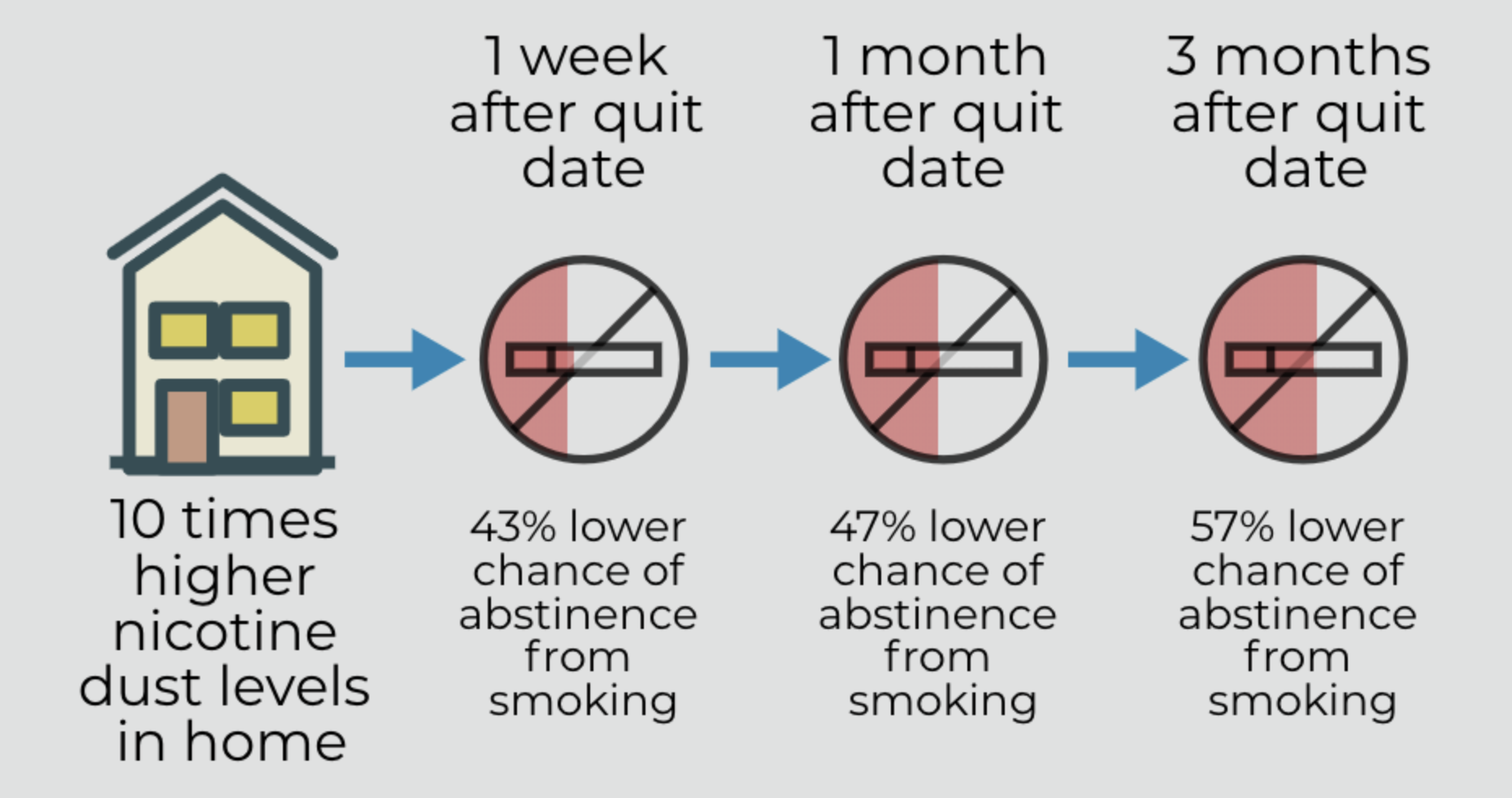ASHES, Vol. 15(8) – The persistence of thirdhand smoke: How do nicotine dust levels in homes influence the chance of successfully quitting smoking?
Exposure to secondhand smoke and “triggers” such as seeing someone else smoking can make it harder to stop smoking. Thirdhand smoke—chemicals from tobacco that linger on surfaces in indoor rooms long after smoke has left the area—might also be harmful. This week, ASHES reviews a study by Georg Matt and colleagues that examined how nicotine residue in the homes of former smokers affected quit attempts.
What was the research question?
What is the relationship between thirdhand smoke in homes (in the form of nicotine dust) and continued abstinence from tobacco smoking?
What did the researchers do?
The researchers analyzed data on levels of tobacco-related chemicals in the body1 and nicotine levels in house dust from 65 cigarette smokers who recently quit smoking. They followed up with each participant to test body tobacco chemical levels at different time periods, including 1 week, 1 month, 3 month, and 6 month time intervals after quitting smoking; this was their measure of continued abstinence. Using logistic regression models, the authors tested how the amount of nicotine in dust in each participant’s home predicted the chance of relapse and abstinence from cigarette smoking at each of the time points. They controlled for several variables2 and hypothesized that exposure to chemicals in thirdhand smoke and their lingering odor may trigger former smokers to relapse.
What did they find?
People living in houses with more nicotine dust had lower rates of continued abstinence from 1 week to 3 months after their quit date. Specifically, a 10-fold increase in nicotine levels in the home was associated with a 57% lower chance of remaining abstinent from cigarette smoking three months after quitting (see figure). This finding remained statistically significant when controlling for other variables. Nicotine levels in the home did not predict abstinence 6 months after quitting.

Figure. Levels of nicotine in smokers’ homes and chance of continued abstinence from smoking at 1 week, 1 month and 3 months. Nicotine dust levels were measured as nicotine concentration, which is the number of micrograms of nicotine per gram of dust (μg/g) in each participant’s home. Click image to enlarge.
Why do these findings matter?
For people who smoke and would like to quit, these results suggest that nicotine residue in their homes could make it harder to quit. Another study found that deep cleaning fabric surfaces inside the home can reduce the amount of nicotine in the home, showing that it is possible to remove thirdhand smoke. Medical professionals who have patients who want to quit should advise their patients to not only avoid secondhand smoke, but also to actively reduce exposure to thirdhand smoke.
Every study has limitations. What are the limitations in this study?
Even though the authors found significant results in their study, their sample was limited to only 65 former smokers in one city, so these results might not generalize to all former smokers. They also did not measure other possible sources of exposure to secondhand and thirdhand smoke, such as walking past a person smoking on the street or tobacco residue on other peoples’ clothing, and these sources could have affected rates of continued abstinence.
For more information:
SmokeFree offers tools and tips about quitting and maintaining abstinence from smoking tobacco. The Center for Disease Control and Prevention offers information and tips about cigarettes and how to quit. For additional tools, please visit the BASIS Addiction Resources page.
— Eric R. Louderback, Ph.D.
What do you think? Please use the comment link below to provide feedback on this article.
________________
1. The authors measured abstinence from smoking by testing each participant’s exhaled breath carbon monoxide at each time point. This approach is a more valid measure of abstinence vs. relapse from smoking, as self-reported abstinence may not correctly reflect actual abstinence from smoking.
2. More specifically, they controlled for participant’s gender, age, military veteran status, years lived in the home, amount of dust in the home (generally) and indoor smoking rates.